#latent homophobia
Text
@hellish-cleric replied to your post “I think it will come as no surprise to anyone that...”:
Yeah, everyone in my party, plus most of the players in my d&d group *hated* Astarion as soon as they met him. Meanwhile, I'm Team Ride or Die for Astarion. I'm a little confused at all the hate he gets.
Oh actually I can answer at least some of this!
He's an obviously camp character who was in a gay relationship (a forced gay relationship but w/e) in an AAA game that is mostly going out to dudebros, and frankly the people who overwhelmingly hate him or kill him immediately the most are straight guys. (The biggest complaints for BG3 are not actually the bugs, but the LGBTQIA+ rep, including being able to have a nonbinary character, or trans character). Within that context, there was already latent Astarion hate in the community that was easy for everyone else to pick up on. So some of it is honestly straight up homophobia!
Then on top of that they gave him PTSD over being saved by someone who then tortured him for 200 years and enslaved him in exchange for that rescue, so he reacts badly every time you save someone, because he doesn't trust that.
And then on top of that he's a complete chaos gremlin. After all, he was tortured and forced to torture people for 200 years, and just about no one maintains much of an ethical backbone after that kind of treatment.
And I think the combo of 'so much of the (guy) community hates Astarion so there's already a background vibe that predisposes people to being suspicious of him' and 'he's camp which hooks into the homophobic folks who don't like that' AND 'he keeps disapproving of me when I do heroic things' (which is a lie, he doesn't always disapprove, and sometimes he actually approves, it depends a lot on context) just kind of turns a lot of folks off him.
He's the only character in the whole story who will actually take you aside privately and comfort you if you do a sexual thing with an NPC later in the game and choose dialogue options that say you were disgusted by doing the thing. He literally takes you aside and starts joking and then is like 'actually... I know what that's like, and I'm so so sorry you had to go through that.'
Dude's fun to meme, hilarious to meme, but he's also the only character who comforts you after you get sexually assaulted/harassed, and in an extremely genuine, 'no strings attached' way. I'm ride or die for that fucker, and I laugh at the folks that turfed him because a bunch of dudes laid a path they walked down.
Like don't get me wrong, some folks just hate him because of the way he looks, the constant disapproval if you're playing a Very Good Character is frustrating, or they have no use for a rogue (they hate loot or maybe they're playing a rogue themselves), or because he can be naff in a battle if you spec him badly / don't know how to spec him out, or for a lot of super understandable reasons! Like, if you never talk your way out of situations, hulk smash a lot in battles, and save people, you're going to get his disapproval AND he won't be as useful in those battles. If you don't sneak around picking off folks, and just go in and smash everyone, he's not as useful as Gale and Wyll who have good AoE, or Lae'zel and Karlach who have amazing 'Hulk Smash' abilities.
I'd avoid him too if I was playing a character who couldn't persuade/deceive/intimidate my way out of situations (which is the best and easiest way to earn his approval), and I might be like 'I don't like Astarion' because of it. He doesn't fit my playstyle! I can't stand Lae'zel for example, because I just don't vibe with 'killing the weak and no one is equal' as a political stance!
But some of it re: Astarion is literally 'a lot of folks are implicitly homophobic and he's easy to hate.'
Frankly I think Dorian (from Dragon Age: Inquisition) would have received a lot more of this too if he'd been more morally questionable as a character when you first meet him. But they made him a 'good' queer so he got more conditional acceptance (and even then, he still got a lot of hate initially!!!)
I am very fortunate that everyone I know personally absolutely love him, and I'm surrounded by a lot of Ride or Die Astarion fans in my personal circle/s both offline and irl and that makes me so incredibly happy.
#hellish-cleric#i have a lot of thoughts about this#and i am absolutely turning off reblogs lmao#because i suspect this fandom could easily be a dumpster fire about this#but a lot of astarion hate is just#latent homophobia#HECK IT'S NOT EVEN LATENT#it's on the surface#i honestly don't get folks who don't earn his approval at all#because you don't have to be a bad / unethical / morally questionable person#to keep his approval decent?#i'm saving everyone#and i'm in Act 2 with Good approval with Astarion#but i did trick the Thorm siblings into killing themselves#in the Shadow-Cursed Lands#and that netted like 8+ approvals from Astarion lmao
49 notes
·
View notes
Text
i can feel a thought forming around dennis not being able to drive the pride float and not being in mac finds his pride altogether. i like to picture him wallowing at home and getting anxiety rage about maybe maybe not being queer and for SURE never being able to be out about it. also jealousy rage about mac being able to figure it out.
#and just his general latent softcore homophobia#that very well could be internalized and probably is#macdennis#to me#mac mcdonald#dennis reynolds#mac finds his pride#iasip#its always sunny in philadelphia
62 notes
·
View notes
Text
Transcription and Translation of Taylor's Little Red Book Livestream (9th December 2023, to the best of my ability)
Q: Question A: Answer
Side Banters:
H: Host T: Taylor Anything in brackets: me or additional elaboration
Q: Asking him to share his experience of city walking in Shanghai earlier today
A: They went to Yu Garden which Taylor said was incredible, and he tried 糖葫蘆 Tanghulu, a traditional Chinese sweet which is candied Chinese Hawthorn
Q: How was the past few days for him and where did he go
A: He's been in China for four nights now (He came by himself btw) First night he stayed at the J Hotel which is the third tallest building in the world and the tallest hotel in the world. After that, he went to 濮院 (the venue for the GQ event) for two nights and it was incredible
Q: How's his jetlag?
A: It's hitting right now 😂 He's been drinking a lot of tea and getting better
Q: What led him to choose to become an actor instead of a competitive swimmer
A: That was an easy choice, he swan for 10 years and then decided he didn't want to swim in college, and then decided he didn't want to be a doctor (his brother's a doctor) and maybe disappointed his parents (H: No way!) It was a hard decision but he decided to move to LA and pursue acting (H: and you made it!)
Q: How is he enjoying being an actor?
A: It's tough, ups and downs. It's kind of like swimming, it's an individual activity, but you also get to collaborate with the community, which is fun.
Q: What are his favourite three movies and why?
A: The Matrix, Fight Club and Interstellar, he likes movie with a twist
Q: What type of music does he like
A: Deep House, Tropical House, Reggaeton
And then the host taught him a couple of Chinese phrases
Q: What sparked his interest in fashion
A: His dad bought him a subscription to GQ when he was younger which started his interest in fashion, and then he started watching fashion-related movies (like Brad Pitt in Allied) which further cultivated that interest. Maybe in the future, he'll try out characters like that
Q: Did he meet any friends in the GQ event?
A: He met Li Xian who he met in Italy earlier, otherwise met a lot of new people.
Q: Why is he passionate about being eco-friendly when it comes to fashion?
A: It was inspired initially by his mom. They lived in the countryside with horses, cows, and fields away from the city, and he has seven siblings (he's the sixth oldest/ third youngest) so there are a lot of hand-me-downs and not a lot of new things, so the family kept on using the same things. He gained a deeper awareness of the issue in recent years.
Q: Talk a bit about fashion sustainability
A: A lot of fast fashion material and clothes are thrown out really soon and disposed of really quickly (despite still being in good shape) but a lot of clothing material, especially synthetic fabric can't be recycled, so it's just like throwing out plastic. Actually, a lot of clothes can keep being reused and styled. He's had the inner shirt he's currently wearing for four years.
Q: Any future plans?
A: He has a film project early next year and there are other things he's excited about but can't talk about yet
Q: Is he going to Shanghai Disneyland?
A: He wants to but he doesn't have time
H: You don't even need to go to Disney you look like a Disney character already! (Damn right!!!)
Q: What food have you had in China so far?
A: Don't get him started on the subject of food 😂 He's had a Shanghainese Lunch today and a Cantonese (YAY) lunch yesterday, and he's looking for some spicy food for tomorrow. Also, he had a really crazy allergic reaction and his lips got giant (???). He needs to be careful with food.
T: I see talk about RWRB, what do you want to know? I'll give some secret intel
(me: YESSSSSSSSSS FINALLY)
RWRB questions speedrun:
Q: sequel?
A: ... He doesn't know. He says he thinks Casey has to write another book for that.
Q: Deleted scenes?
A: They're deleted for a reason (DUDE)
Q: BTS?
A: He says he has some on his phone and he would show us but he doesn't have his phone right now, he might post it later (PLEASE DO)
H: He's leaving after three days
T: (reading off comments) Come visit Hong Kong next time? Yeah! (me, who lives in Hong Kong: AHHHHHHHHHH)
Q: Do you know any Chinese nicknames of yours?
A: 忒樂. (tei le, or "Tay"-le) meaning too happy (I made a list of the boys' Chinese nicknames here)
Annddd... That's it! The live was pretty short, like 20 minutes? He ended it by picking up the phone and showing the audience the Shanghai city view himself (I was too busy typing to get a screenshot)
All transcription or interpretation mistakes are mine
#rwrb#red white and royal blue#rwrb movie#taylor zakhar perez#alex claremont diaz#holy shit this was exiciting#i haven't done transcription in three years#also something I wanted to note but it's speculation so I'm putting it in the tags#Taylor had to point out RWRB himself even though most of the comments were about RWRB followed by please come to xx city#Even during watching the live i kept thinking why isn't the host mentioning RWRB at all Taylor read RWRB himself#but I have two speculations#either this was in collaboration with a fashion brand so they wanted to put the focus on fashion#but in that case Taylor never mentioned the brand or it was never plugged in like a commercial live stream would#Even the account is Taylor's own account and not a brand account#or it's China's latent homophobia :) which in that case FUCCCKKKK#meraki translates
73 notes
·
View notes
Text
normal person discourse: real people can't queerbait, they're not characters in a show
daniel ricciardo, about to make a homophobic will-they-won't-they gay joke abt his teammate that convinces thousands of people they're actually having sex: uhhhh
#sorry to my good pal lovely friend you know who you are [just posted maxiel]#but maxiel is a collective delusion fuelled exclusively by the driving force of daniel's latent laddy homophobia. thems the facts#multiple drivers r guilty of this dont get me wrong but ricciardo is the worst offender by far#his career is a game of gay chicken both with tangible consistent success and every teammate hes ever had#and he always chickens out<3#sorry this is a very petty post fhdsjkfhdjs ignore me its past midnight and ive had a couple drinks#meta
10 notes
·
View notes
Text
I am trying to write my original characters again after like a year of barren google docs and WHOO BABY
#this sucks#at least its homoerotic I mean I still have that#why is everything I write packed to the brim with internalized homophobia is this the latent catholicism I thought I stamped out at ten???
7 notes
·
View notes
Text
These girlies with the "Prince of Pegging" gag all giggling behind their hands are so fucking laaaaaaaaaame. And I bet they swear up and down they're the righteous and progressive side of the fandom. Like take a second to examine here, why do you think there's something embarrassing about being pegged? You think a sex act is emasculating? Why? Because you associate it with gay sex? And why is it that you think gay sex is emasculating? Microphone to your faces bitches, do you think there's something inherently humiliating about being gay, yes or no????
#every time i see that godforsaken tag trending on twitter i lose another year off my life#mostly bc of the latent homophobia#but partly bc who the hell wants to think of william in any kind of sex act ever#but no yeah mostly the homophobia
5 notes
·
View notes
Text
So I've seen a few too many people on twitter talking about The Kiss Scene from the new Scott Pilgrim anime. People saying it's fetishistic and indulgent, people calling it male gazey, etc. And while the kiss itself is certainly a bit exaggerated, I felt like writing a bit about why I disagree, and why context is important, like it always is. But it basically turned into an extended analysis on the metatextual treatment of Roxie Richter. So bear with me. It's a long post.
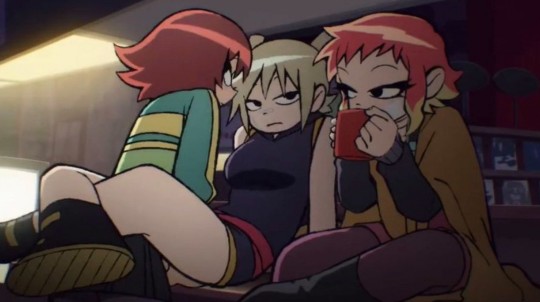
What really matters about this scene is not the kiss itself, but what precedes it. Not even just the fight scene just before it, but what precedes the whole anime series, really. And that's the Scott Pilgrim comic book, and the live action movie. Because in both, Roxie is a punchline.
She's a joke. Her character starts and ends with "one of the exes is actually a girl, I bet you didn't expect that." Jokes are made about Ramona's latent bisexuality, the movie especially treating it as funny and absurd, and her validity as a romantic interest is entirely written off by Ramona as being "just a phase." There's a fight scene, she's defeated by a man giving her an orgasm which implicitly calls her sexuality into question (come on), and the movie just moves on. It sucks. It really, really sucks.
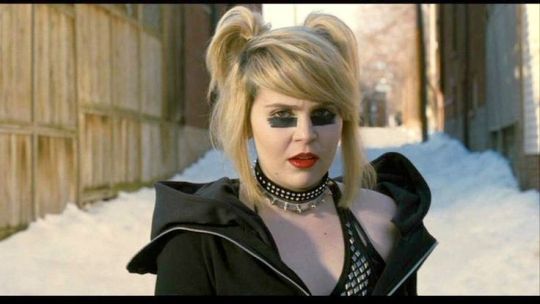
The comic fares a little better. It never veers into outright homophobia like the movie does, and while the line about Ramona having gone through a phase remains, Roxie actually gets one over on Scott when Ramona briefly gets back with Roxie. But Roxie is still only barely a character. Like all the other evil exes, she's just a stepping stone towards the male protagonist's development. She barely even gets any screentime before she's defeated by Scott's "power of love." But Roxie stands out, since she's the only villain who is queer, or at least had been confirmed queer at that point (hi Todd). In a series that champions multiple gay men in the supporting cast, the single undeniable lesbian in the story is a villain. She's labeled as evil, made fun of, pushed aside in favor of the men, and then discarded. Her screentime was never about her, or her feelings for Ramona. It was about the straight, male protagonist needing to overcome her. And that was Roxie Richter. An unfortunate victim of the 2010s.
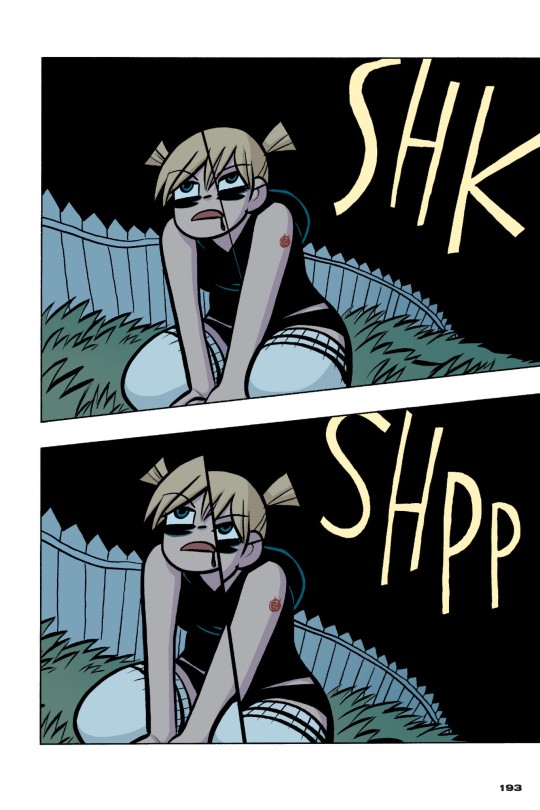
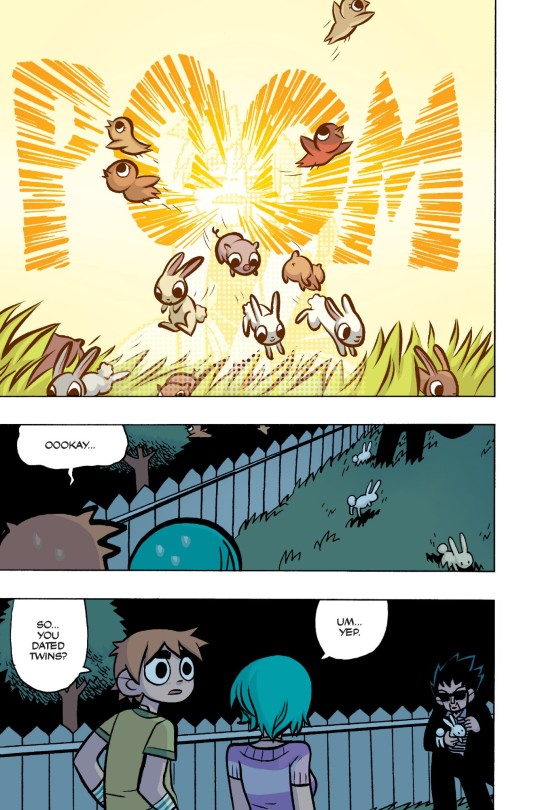
Fast forward to current year, and the new anime series is announced. Everybody sits down to watch the new series expecting another retelling of the same story, and.... hang on, that straight male protagonist I mentioned just died in the first episode. And now it's humanizing the villains from the original story. And there's Roxie, introduced alongside the other evil exes in the second episode, and she's being played entirely straight, without a punchline in sight. No jokes are made about her gender, no questions are made of her validity as one of Ramona's romantic interests. The narrative considers her important. In one episode, she already gets more respect than she did in either of the previous iterations of Scott Pilgrim. And this isn't even her focus episode yet... which happens to be the very next one.
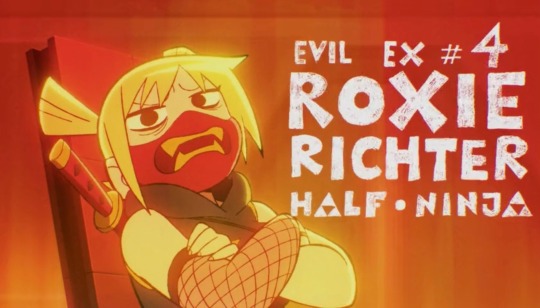
The anime series goes to great lengths to flesh out the original story's villains and to have Ramona reconcile with them. And I don't think it's a coincidence that Roxie gets to go first. While Matthew Patel gets his development in episode 2, Roxie is the first to directly confront Ramona, now our main protagonist. This is notable too because it's the only time the exes are encountered out of order. Roxie is supposed to be number 4, but she's first in line, and later on you realize that she's the only one who's out of sequence. She's the one who sets the precedent for the villains being redeemed. She's the most important character for Ramona to reconcile with.
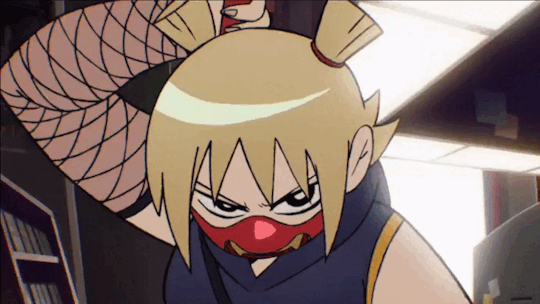
What follows is probably the most extensive, elaborate 1 on 1 fight scene in the whole show. Roxie fights like a wounded animal, her motions are desperate and pained. Ramona can only barely fight back against her onslaught. Different set-pieces fly by at breakneck speed as Roxie relentlessly lays her feelings at Ramona's feet through her attacks and her distraught shouts. And unlike the comic or the movie, Ramona acknowledges them, and sincerely apologizes. And the two end up just laying there, exhausted, reminiscing about when they were together.
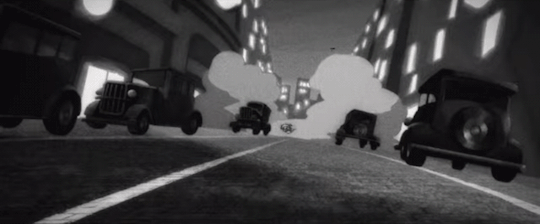


Only after this, after all of this, does the kiss scene happen. Roxie has been vindicated, she has reconciled with the person who hurt her, the narrative has deemed that her anger is justified and has redeemed her character. And she gets her victory lap by making the nearest other hot girl question her heterosexuality, sharing a sloppy kiss with her as the music triumphantly crescendos.
It's... a little self-congratulatory, honestly. But it's good. It's redemption for a character who had been mistreated for over a decade. And she punctuates the moment by being very, very gay where everyone can see it, no men anywhere in sight. Because this is her moment. And then she leaves the plot, on her own accord this time, while humming the hampster dance. What a legend. How could anything be wrong with this.

#scott pilgrim#spto#scott pilgrim takes off#roxie richter#roxanne richter#scott pilgrim spoilers#spto spoilers
19K notes
·
View notes
Text
IMO! If kids face abuse to prevent them from becoming queer, regardless of whether or how that possibility manifests later in life, we should not be quarreling over whether that "counts" as homophobia. Because if they do turn out heterosexual, I don't think their latent heterosexuality was doing them any favors. If I were to recount my experiences with homophobia, surely you wouldn't tell me I could only start with the moment I came out, or that I couldn't count the comments of strangers who don't technically know my sexual orientation. Sorry to be annoying but with the historicity of queerness and how it's deployed on an "I know it when I see it" basis make it hard to say what counts and doesn't, which is why queer theorists are less inclined to make it an identity politics of discrete categories. I also think, say, sex workers are positionally queer regardless of identity. IMO!
#i have a few examples that i would consider 'positionally queer' but i don't want anyone to get mad#like children: in general!
118 notes
·
View notes
Text
So I finally showed my mum Nimona today! I knew she’d enjoy it, and she did!
But afterwards she was like “I’m not sure why the knights had to have a romantic relationship besides that it’s nice to have the representation… I just feel like not everything needs a romance. Does it add anything, for it to be romantic?”
(this is not latent homophobia btw I know my mum and her stated reasoning was genuine)
So I started talking about how with Nimona herself as a gender fluidity allegory, having Ballister as a gay man raised in this restrictive society draws some good parallels to how the conservative establishment tries to pry the queer community apart, divide and conquer, and Bal doesn’t understand Nimona at first and thinks she’s ‘too much’, but once he learns to trust her knowledge of herself and recognizes the institutions (ha) are going to throw them both away equally he manages to be there for her and be exactly the support she needs
and two interesting things came of this conversation
First of all, my mum just kinda blinked at me at the end of it and then went “…that’s really insightful, and you’re right. That is a good reason for it to be a romantic relationship.” So that felt good.
But the other thing is that when I first mentioned Nimona as genderfluid she kinda cocked her head at me, so I laid that out a bit, talking about their conversation in the alley, needing to be able to shift and have all the different versions of her acknowledged as her, the “I’m Nimona”, being externally called a monster for not fitting into the boxes, etc
and she gave me this curious look and said kind of carefully
“I think that’s something that would be really clear to a genderqueer or genderfluid person, and I’m glad it’s there.”
which is lovely and I think it translates to
“my genderfluid child noticed something in this movie that went completely over my head”
75 notes
·
View notes
Text
in the replies/reblogs of the post I made about artists swapping ed and stede's body types and how it's racist, people have also been mentioning the latent homophobia and how people Stede being femme kind of leans into the twinkifying of him. Society sees femininity as small, which, while I understand the homophobic/sexist bias there, I just have not for one second thought that making Stede smaller makes any sense. Because yeah, Stede is femme, but also BIG and LOUD and OBNOXIOUS about it. Stede takes up space!!! That's what made him so out of place at home, he took up too much space and in the wrong way. Wherever he goes, he leaves a big fucking signature that says "STEDE BONNET WAS HERE!" That's part of the reason he hates himself! He can't stop leaving his mark! Stede Bonnet is not a Small character and it's insane to me that his femininity overpowers his unabashed Bigness for some artists.
#izzy still thinks he's taking up space wrong- 'what a perverse misuse of space'#ofmd#our flag means death#stede bonnet
164 notes
·
View notes
Text
Ok I got four asks in my inbox about the new Nick interview and I'm actually mad. I'm actually livid and exasperated because I've been getting and answering similar asks over and over again, and yet people still come to me with the same statement and the same conviction EVEN AFTER I POINTED OUT EVERY FUCKING FACT THAT CONTRADICTS IT.
Do you really need a 19-year-old to teach you reading comprehension and media literacy?
Ok, fine.
Statement One: Nick doesn't appreciate RWRB, he's brushing it aside, which is why it wasn't mentioned in the New York Times
One: Editorials don't always portray the actual thoughts or agenda of the interviewee.
Unlike a video interview or a podcast interview where we can hear the whole conversation directly from Nick with his voice, and even if there are cuts and edits we can pick it up via visual or audio continuity, in a written editorial the only thing we can rely on is the writer's words, or in other words, the writer's paraphrase or quotation of what Nick said to him. This gives much bigger room for any changes or manipulation in content because we have nothing else to reference.
It is clear that in the past three editorials, the writer or the magazine itself has deliberately demeaning and devaluing RWRB. In NY Magazine, it was only mentioned in one line and degraded to "a queer take on a common straight trope" (see the choice of word "president's daughter"), with the implication being at its core, it's a straight story/ reliant on past straight stories to be interesting; Hunger Magazine calls it fujoshi-pleasing (fujoshi: Japanese slang, denoting how a straight woman who enjoys fictional gay content is "rotten", too ruined to be married, an insult to both the audience/fans and the movie itself ); and this time New York Magazine didn't even mention RWRB, when let's be honest, it's Nick's biggest breakout role.
"Once Is Chance, Twice is Coincidence, Third Time's A Pattern" this is deliberate. I can't say what the agenda is, my guess is some extent of latent homophobia, but it's clear that this is a fucking pattern. In fact, besides the hidden agenda of devaluing RWRB, these editorials show another hidden agenda, but that's something for a later day. PM me id you want to now, I won't discuss that one on my public platform yet.
Again, there is so much more room for twisting and hiding words in a written editorial. In all the video interviews Nick did, especially in the UK, when has he ever avoided a question about RWRB? When has he ever not shown gratitude towards the project?
Two: In all video evidence that can't be manipulated, that clearly shows Nick's own thoughts which not influenced by any other party, he has made it clear that he adores RWRB.
Why else would he sign books during the M&G London premiere, going as far as to stay behind after the event just to sign books? Same with the LA M&G premiere and TIOY premiere: those were promotions for other projects, he had a valid reason to refuse to sign the RWRB books and posters, but he didn't, always signing with a big smile on his face, even playfully signing on Taylor's face. He said it himself in his Instagram post, and I quote: "The love that Henry has received has been one of the most heartwarming things to watch. It's been difficult to not talk about him. So thank you for seeing him for all he is. He was a joy to bring to life." There's your proof, directly from the man himself.
Statement Two: Nick's not interested in doing a sequel, he said he's done playing princes and he's done playing romantic leads
One: "Done playing princes" doesn't mean literally done playing princes, it means he wants to try more roles and not be stuck with only being known as the "prince" guy. (even though he's literally a prince lol)
Plus, he said that after Robert, but then Henry came along and he was attracted to Henry as a character with his scared but loving heart. He doesn't just view Henry as a prince, he views Henry as a complex, delicate person who so happens to be a prince. Him saying he's done playing princes means in the future, he doesn't really want another royal on his filmography, but this doesn't mean he doesn't want to continue Henry's story. With the given context, namely asking him about future projects he wants to take up, "he's done playing princes" and "he doesn't want to play Henry anymore" are not mutually inclusive.
Two: "Done playing romantic leads" means he wants to try new things and take up new projects that aren't romance films.
This doesn't include the continuation of already established characters i.e. sequels, this just means if he were to take up brand new projects, he wants to try something else. Sequels are inherently different from new projects because again, sequels are based on already established characters.
Three: He said several times ON VIDEO that he'd be in for a sequel
In this one, when asked if he'd be up for a sequel, he said, and I quote "Look, I think with any opportunity of doing a sequel, I think, you know, the script has to be right. But obviously, it was so lovely to see how many people it touched and having that resonance is incredibly important to me, so, yeah. Of course."
In this one, when asked if they have had conservation on a potential sequel, he said, and again I quote: "Yeah, I mean definitely had conversations. I think we're all on the same page in the sense that, you know, the script needs to be right, and sort of all the different components need to be right because we made something that has such a positive effect and I think the last thing you'd wanna do is ruin that or take that in a way, so, you know, the conversations are definitely being had."
And there are more videos from red carpet interviews that I can't be bothered to find right now but he says more or less the same thing.
(look I even transcribed it)
Not only is he on board with a sequel, he's also being careful about it to make sure once they do get to making it, it's something good. He's on board, and he values it. And again, that's directly from him.
We have a phrase in Chinese: 斷章取義, meaning "breaking off a small part of an article and deriving the meaning from that single part" That's what so many of you, in particular, the people who come to my inbox with the sentiments of the above-mentioned statement are doing. Please, use critical thinking and look at the whole picture. Stop making judgments from the surface of one source.
Tagging my friends @alittlefrenchtree and @myteavsricochet because it looks like they've been getting the same things I got
#rwrb#red white and royal blue#rwrb movie#nicholas galitzine#henry fox mountchristen windsor#henry hanover stuart fox#rwrb thoughts#meraki essay#i'm not someone who gets mad easily but I've had enough of this#nick galitzine
101 notes
·
View notes
Text
Progressing through Orson Scott Card's Ender Saga. Currently up to "Children Of The Mind", and good fucking lord these chapters with Wang-mu and 'Peter' are such an utterly fucking atrocious trainwreck.
Can anyone in the Ender's Game fandom explain this to me please??
Why are these characters in the Sixth fucking Millennium A.D. talking about "Asians", "Europeans", and "Americans"; and their identities thereof, as if those are even REMOTELY meaningful categories of culture to the peoples of a humanity that have been spreading out into and colonising outer space for over three thousand years?????
Like, right now where I'm up to, Wang-mu and 'Peter' are having their first little conversation with Ainmaina Hikari, and Wang-mu is breezily bullshitting about Ancient Egypt/China/Mesopotamia or whatever
And, like, those ancient cultures are as far-removed from me, the reader, as China/Japan/America are from Wang-mu/Hikari/'Peter'!
If you were to squint hard enough, yeah, it could be said that my distant ancestors came from the Roman Empire, but, fuck no there is no way in heaven or hell that the culture of those 3500-years-ago ancestors and their neighbourly relations with other cultures and peoples has ANY kind of bearing on my life or cultural outlooks.
Like, I'm not gunna give the side-eye to some random stranger I meet whose culture mores seem different to mine and start waxing poetic about "oh he's just like that because he's a Carthaginian. 🙄😒 You all know what Carthaginians are like amirite?? "
(I guess 'Peter' is technically an American—or a 'cloned' caricature of one, at least—so he gets a pass on this)
The Doyleist explanation is that Orson Scott Card simply didn't have the sci-fi chops to imbue his creation with coherence; he's just trying to tell a story here and doesn't have the Tolkienian level of galaxy-brain required to convincingly pull off the 3000+ years of history and sociology experienced by his humanity across its umpteen number of colony worlds, so he's just sticking to what he knew and is hand-waving away the shockingly breathtaking levels of cultural stagnation his humanity has wallowed in.
But what's the Watsonian explanation for that cultural stagnation?? Is there a Watsonian explanation??
(also, what's with Miro's latent homophobia?? Is he Like That because of Card's own intense homophobia shining through, or is it simply because Miro grew up on The Catholic Planet?)
21 notes
·
View notes
Note
do you think if aziraphale and crowley were women (played by actresses) the media literacy would be on the same level
Let’s not get ahead of ourselves I think the media literacy is still bad with regards to good omens as it is, it’s just really not on the scale of what every other large fandom is like. And no I think people would be even worse if it was lesbians and also they probably wouldn’t have even gotten to kiss (not out of any conscious homophobia just the latent homophobia of “it’s harder for straight people to read chemistry between women as romantic”)
25 notes
·
View notes
Text
I Guess Her Generation Isn't Cool With Witchcraft (Gingerbread)
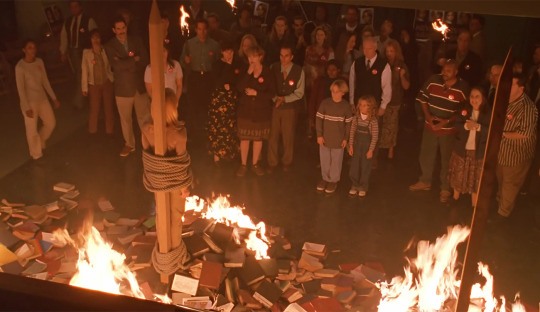
On the 24th May 1988 the Conservative government of Great Britain, led by Margaret Thatcher, passed a law known officially as the United Kingdom Local Government Act 1988. This Act had many effects, but by far its most famous and influential section was the part that has come to be known as Section 28. Section 28 outlawed any school or local authority in the United Kingdom from “promoting homosexuality”, “publishing any material with the intention of promoting homosexuality”, or “promoting the teaching of the acceptability of homosexuality as a pretended family relationship”. Given that the act (intentionally) made no effort to define “promotion”, the effect was clear and predesigned: from 1988 until its full repeal in 2003, queerness was illegal in British schools.
This justification for this discrimination was the same one that is always trotted out - the protection of children from predatory influences. Homophobic attitudes were rising in the wake of the HIV/AIDS epidemic, whipped up by an entrenched conservative government and a vulturine news industry. The likes of The Sun, Daily Mail, and The Telegraph ran regular scare pieces about the homosexual lifestyle and its apparent attempts to indoctrinate children. The most benign depictions of queer acceptance were accused of being pornographic, of being propagandic, of “glorifying homosexual intercourse”. One book - Jenny Lives With Eric And Martin - was described by The Sun as “vile” and Today as “gay porn”[1], and was deemed controversial enough to kickstart the movement that resulted in Section 28. It depicts a girl with a gay father, engaging in such salacious events as going to the laundrette, and planning a birthday party.
The accusations leveled at these books were lies, and easily revealed as lies to anyone concerned enough to engage in actual research, but their purpose was not to be true. Their purpose was to combine latent homophobia in the general population with the instinctive human desire to protect the young. Together, these elements create a powerful boogeyman. This boogeyman was then paraded out during the general election of 1987, in which the Labour Party was attacked for their (claimed) promotion of such offensive materials. This was an imagined threat cooked up by bigots and seized upon by political actors most interested in protecting their capital. It worked. The Conservatives won the election with 42% of the vote, and remained in power until 1997.
It is into this cultural landscape that Buffy airs the eleventh episode of Season Three, Gingerbread. The plot revolves around the deaths of two young children, and how those deaths spark a wave of anti-witch paranoia among the townsfolk of Sunnydale; a paranoia that escalates into censorship, persecution, and eventually a literal witch-burning. The dead children are eventually revealed to be an evil demon exerting some kind of mind control on the population, which is standard practice for Buffy hijinks. The important aspects are the real-world parallels that this storyline is intending to highlight.
Read More
#btvs#buffy the vampire slayer#btvs meta#meta#essay#insect reflection#s3#gingerbread#buffy summers#willow rosenberg#theme: queerness#racism#section 28
98 notes
·
View notes
Text
Getting real tired of people blaming John's villainy on misogyny and missing the entire point of his arc. Like, John's issue wasn't his treatment of women, though I won't deny that there is some latent misogyny that would have remained given that he's the only one to remember the earth as it was pre-apocalypse, but that's the point.
John is the only one who remembers and pointedly so.
Given extreme and ultimately final power, John chooses to remake the world in an image he thinks is good and just. Notably, this is an empire where sexism and homophobia is absent. While there are questions of agency and bodily autonomy, it has to do with the dignity of the corpse and is almost never positioned as sexual, Harrow's adolescent awakening and the romantic nature of John/Alecto aside, and even those are positioned as desire that isn't forced upon anyone until the end when it's Alecto going around kissing people (I'd argue that that isn't non-con either though).*
What lies at the heart of John's arc is a question of power and if the human mind can handle the breadth and width of the gift Alecto gave him without losing himself to the process. Like, Muir makes it a point in The Unwanted Guest to establish that the souls of the necromancers and their cavaliers who become Lyctors eventually blend together, something that was shown to us first in the ascendency of CamPal to become Paul (and there's so much to unpack with that specific choice of name).
So what happens when the soul you mix with is an entire planet/a man who's been the subject of his own oppressions vis a vis colonialism in New Zealand? What happens when someone is given the power to achieve the sum totality of their ideals but then also has to live with the weight of his crimes for 10000 years? How does that strip him of his humanity?
To be honest, I think that's a much more interesting deconstruction than simply blaming misogyny for it.
*That's not to say thst the Empire is devoid of a gender binary, but it's framed as necro/cav. The man eliminated the patriarchy only to create a whole new system of oppression in it's place.
#paladin reads#the locked tomb#gideon the ninth#john gaius#all the john the misogynist analyses are lazy and reaches for the lowest hanging fruit possible
16 notes
·
View notes
Text
Out West, the Gay Cowboy Roams Free
The frontier has long been a symbol of American masculinity. Now a rising generation of artists are creating a new queer mythology.

The gay cowboy ensemble — Manu Rios (from left), José Condessa, Jason Fernández and George Steane — from Pedro Almodóvar’s “Strange Way of Life” (2023), photographed in Madrid on July 12, 2023. From left: Y/Project shirt, about $715, yproject.fr; and Cartier ring, $3,700, cartier.com. Loewe shirt, showpiece only, and jeans, $990, loewe.com. Gucci T-shirt, $590, gucci.com; Levi’s jeans, $98, levis.com; and stylist’s own belt. Gucci shirt, $2,100, and jeans, $1,300.Credit...Photograph by Carlota Guerrero. Styled by Alicia Padrón
By Evan Moffitt
Published Sept. 5, 2023 Updated Sept. 27, 2023
TWO MEN, A grizzled sheriff and a gunslinging vigilante, confront each other in a dusty saloon town. It’s a scene familiar from countless western films, but in Pedro Almodóvar’s new short, “Strange Way of Life,” in theaters next month, only a few minutes elapse before the two characters end up in bed together. When Silva (Pedro Pascal) visits his former lover Jake (Ethan Hawke), he rekindles their romance before revealing less amorous intentions. Intrigue ensues, and the shock of two gay cowboys gives way to what we might expect from a classic western: shootouts, horseback chases, fugitive justice. Almodóvar’s second film in English forgoes the melodrama for which he is best known, adhering instead to genre traditions, so “the interrupted and then resumed love story between these two men will be taken more seriously,” the 73-year-old Spanish director says.
In America, as Almodóvar knows, cowboys are serious business. They might be our national paragon of masculinity: Generations of American boys were taught that real men should have the swagger of the Marlboro Man and the gruff voice of John Wayne. But like so many aspects of gender, those were just performances. This is partly why over the decades many queer artists have made winking references to cowboy culture. By homing in on make-believe and dress up, they’ve deflated some of its homophobia-tinged machismo — and even sometimes turned it into an object of horny fun. Campy versions of the Lone Ranger’s costume appear in explicit photographs by Bob Mizer from the 1950s that were distributed in physique pictorials, a forerunner of gay porn magazines. In 1965, Andy Warhol directed some friends in a western-themed striptease for his film “Horse”; three years later, he released “Lonesome Cowboys,” a drunken romp among five gay gauchos, a madam and a cross-dressing sheriff. Then there was the gay disco troupe the Village People’s dime-store cowboy, Randy Jones, who was meant to be read as a tongue-in-cheek archetype (one since referenced by musicians like Lil Nas X and Orville Peck).

Oscar yi Hou’s “Coolieisms, a.k.a.: The Fugitive (John Chinaman)” (2023). Photo: Evan Sheldon. Courtesy of the artist, 12.26, Dallas, Los Angeles, and James Fuentes, New York, Los Angeles
While such appropriations subvert the straightness of cowboy culture, they also highlight its latent homoeroticism. From cattle drives to prisons to navy ships, men will often have sex with each other when there aren’t any women around. Western films in particular are spectacles of rowdy male bonding on the open range, where a lot can happen after a drink or three. There’s palpable sexual tension in the 1969 buddy drama “Butch Cassidy and the Sundance Kid” and the 1959 classic “Warlock,” from which Almodóvar took inspiration. In the 1970s, men in urban gay enclaves began wearing Stetsons and bandannas color-coded to indicate their sexual proclivities. These gestures weren’t entirely ironic; they also reclaimed a masculinity that gay men were told they lacked.
As lone riders in a land characterized as empty and lawless, cowboys were also a perfect symbol for queers seeking to liberate and reinvent themselves. Such is the fragile hope of “Brokeback Mountain,” the 2005 blockbuster (which Almodóvar turned down an offer to direct) that was adapted into a West End play earlier this year. Its portrayal of a doomed love affair between two male shepherds was groundbreaking in many ways, but its presentation of the West as somewhere white, masculine men might be safe to explore their desires for each other without ever having to run into anyone else — including a person of color — mostly followed conventional tropes.
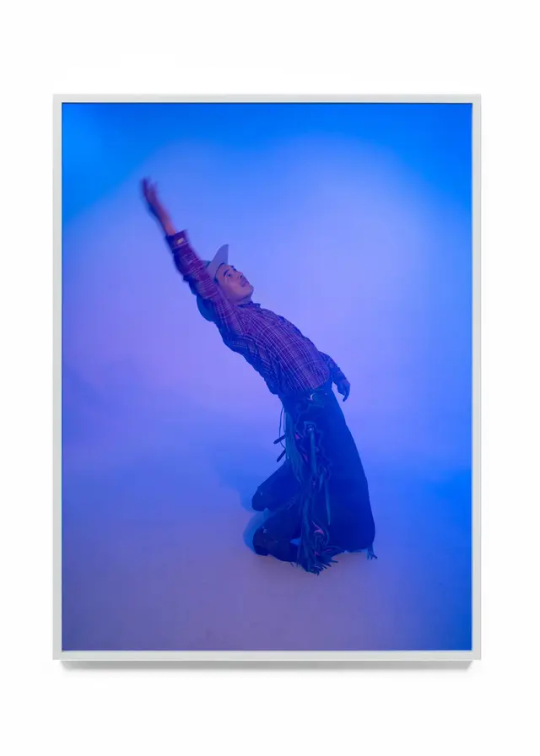
Kenneth Tam’s “Rabbit” (2022). Courtesy of the artist and Commonwealth and Council, Los Angeles, Mexico City © Kenneth Tam. Photo documentation: Ian Byers-Gamber
NEARLY 20 YEARS later, several younger artists and filmmakers are developing a more nuanced vision of queerness in the American West, with particular emphasis on the country’s changing race and gender dynamics. This builds on past efforts by writers, artists and filmmakers like Kahlil Joseph and Chandra McCormick to celebrate the many nonwhite cowboys who have always been an essential part of American life.
“National Anthem,” a feature film written and directed by the Los Angeles photographer Luke Gilford that premiered at South by Southwest in March, chronicles queer rodeos and ranches in the Southwest. Many of the movie’s diverse characters and the actors who play them identify as trans. Notably, while the plot hinges on relatable, everyday dramas (jealousy in open relationships, the pain of a first heartbreak), homophobia and transphobia are mostly absent — a reminder that queer life needn’t be defined by a culture that oppresses it.
The frontier has always been a place where people have come to live on their own terms. At the turn of the 20th century, the trans huckster Harry Allen was a notorious outlaw in the Pacific Northwest. Hundreds of newspaper reports from the era reveal that trans cowboys weren’t uncommon in the West, even if they’re absent from official accounts. When the 32-year-old artist Gray Wielebinski was growing up in Dallas, he saw 10-gallon hats and boots as the marks of a fantastical machismo that belonged as much to him as to cisgender men. In 2022, the trans-masc artist erected a mechanical bull at Bold Tendencies, an arts organization that stages shows on the roof of a disused South London parking structure, where visitors were invited to take a ride that, like sex, was brief but ecstatic. The bull bucked in a ring of fencing set with stained-glass panels that recalled gay bars and public cruising sites, which Wielebinski notes are at risk of disappearing because of gentrification. In his work, the cowboy is a tragic figure professionally endangered by commercial ranching, making him an analogue to the queer establishments that have closed in recent years.

Rafa Esparza’s “Al Tempo” (2021). Courtesy of the artist and Commonwealth and Council, Los Angeles, Mexico City
“Cowboys only live in a sense as myth,” says Nora Burnett Abrams, a director at the Denver Museum of Contemporary Art, which will open the expansive exhibition “Cowboy” this month. “But you also have this lived experience of contemporary cowboy life and a culture far more diverse not just in terms of identity but also labor and function.” A new installation and video by the artists Rafa Esparza, 41, and Fabian Guerrero, 35, will document the queer cowboy bars popular among Mexican and Central American immigrants throughout the Southwestern United States. Esparza’s 2021 diptych “Al Tempo,” painted on adobe, distills one such scene: gay Latino couples in sombreros dancing under the soft lights of Club Tempo, an East Hollywood institution. Esparza, who grew up in nearby East Pasadena, visited the venue for the first time in the late 1990s. “I remember thinking, ‘My dad or my uncles could very well be here, and I wouldn’t be able to set them apart from everyone else,’” he recalls. “It felt like a beautiful, queer version of what my family members have striven to preserve of their life back in Mexico.”
The dreamy scenes in the Austin, Texas-based 34-year-old artist RF. Alvarez’s paintings, which were on view at Alanna Miller Gallery in Manhattan through June, on the other hand, are mostly imagined. White and Latino men dine outdoors and lie naked in bed together. Cowboy hats abound: in a self-portrait of the artist wearing nothing but white briefs and in a still life hanging above a wardrobe beside a silhouetted portrait of a gay male couple. The paintings are a kind of reclamation — of history, but also of space. “There is no place for me in the West,” Alvarez says. “But multitudes can exist.”

RF. Alvarez’s “Luncheon on the Pasture” (2022). Courtesy of the artist and Taymour Grahne Projects
OTHER ARTISTS ARE mining time instead of place, looking at the past for clues to the inner queer lives of those who have been removed from most historical accounts of the West. In the artist Kenneth Tam’s 2021 film, “Silent Spikes,” also included in the Denver show, Asian American men in cowboy garb pose and dance in front of a purple backdrop, intercut with footage of railroad tunnels dug by Chinese immigrant workers in the 1860s. The piece imagines what kinds of relationships might have formed among these laborers, who were treated brutally and paid poorly. “I wanted to think about how their bodies must have felt against one another’s in that space, working together in close proximity,” says Tam, who is straight but whose work, he adds, is concerned with homosocial dynamics. Scant evidence of the Chinese laborers’ lives has survived, so Tam’s vision of them as queer cowboys becomes a speculative attempt to complete the record.
Stills from the film were on display this summer in “The Range,” an exhibition at 12.26 Gallery in Dallas that likewise explored cowboy iconography. There, they hung near paintings by Oscar yi Hou, 24, a British-born, New York-based artist whose works are replete with clichéd signifiers of Asian and American identity, including cowboy hats and details from the Japanese anime series “Dragon Ball Z.” His solo exhibition at the Brooklyn Museum, which closes later this month, includes a self-portrait of the artist as a muscled, pickax-wielding miner, his pose modeled on a 1970s flyer for the Manhattan gay bar the Mineshaft, referencing both cruising culture and those same railway workers. Another buff Chinese laborer appears in a black leather bondage mask and cowboy hat in “Coolieisms, a.k.a.: Leather Daddy’s Highbinder Odalisque” (2022) — the series’ title riffing on a slur for immigrants from Asia — holding his long braid like a whip.
The work is “about the American cult of masculinity and rugged individualism ... conquering the ‘uncivilized West’ — and how this gender ideology dovetails with American expansionism,” says yi Hou. The raw sexual power of his subjects refutes stereotypes of Asian masculinity while offering a fantasy about how the Chinese men who literally built the West might have explored their own desires. In challenging the outdated image of the cowboy as a white, cisgender macho man, clearing the land in the name of racial purity, they suggest that America’s national mythology can be made to speak for everyone in it — that the West is more expansive after all.
Hair by Olga Holovanova at Another Agency using GHD. Makeup by Lucas Margarit at Another Agency using Dior Beauty. Set design by Cito Ballesta. Photo assistant: Guillermo Tejedor. Stylist’s assistant: Irene Monje. Produced by Alana Productions SL
#Cowboys#Queer cowboys#Gay cowboys#Cowboy art#Queer art#Gay art#LGBTQ+#LGBTQ#LGBTQ media#Strange Way of Life#Pedro Almodóvar#Pedro Pascal#Ethan Hawke
28 notes
·
View notes